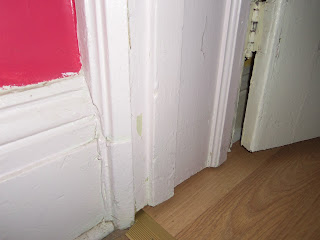One important aspect of the Dayton House is the amount of intact woodwork. Over the years, the original integrity of the configuration of the house and the craftsmanship of its components remained surprisingly untouched and largely unaltered. Perhaps one reason for the near pristine and authentic quality of the work was that it was done so well to begin with and because the house was never vacant. And although it is a zoned multi-dwelling residence, it has always been owner occupied.
The early owners of the Dayton House were affluent citizens. A house of this style and construction would not have been built by a laborer, but more likely a mill or factory owner. First of all, solid brick/masonry construction was the most costly form of building. It would be today as well – if that form of construction was still employed. It’s not, mostly because it is so costly. The house was built in three stages and each stage was the same method of construction.
Baseboard moulding in c.1840 (original) section of the house
Woodwork and moulding in c.1870 addition of house
Another hallmark of affluent construction and design is the use of quality wood and decorative moldings. While the Dayton House may seem inferior to more showy styles (such as Victorian), it is no less impressive with its simple style door and window frames and baseboards. The ogee style of the woodwork is historically significant for the time in which it was produced. Even more significant is that the style and quality was carried on throughout the entire house. In many homes, only the public rooms received this decorative treatment. The builders of the Dayton House, at each stage, had ample funds to employ this decorative detail to both public and private rooms.
Window sill moulding in Dining Room
Baseboard in Office/Small room off Dining Room
Upstairs Bathroom - with authentic/period tub, baseboards and Windows, original
Upstairs Bedroom, showing imrpessive molding for a non-public room
That this house was well built to start and has been dutifully maintained is obvious in the fact that most of the original components remain. That there is so much original intact detailing is a blessing. It is far easier to move into a historic house that is intact, than it is to take on one that needs to be restored. The Dayton House is fortunate that it has always been occupied by owners who care about it and who want to see it survive into the future. The original builder and subsequent builders did their part by constructing a home of quality. Everyone who has lived here since has benefited from their work and obviously felt committed to maintaining it. There are many aspects of the house that speak to this sense of importance. But perhaps one of the most obvious example is found in the woodwork itself.







No comments:
Post a Comment